Recent Storm Damage Posts
5 Essential Steps for Effective Flood Cleanup in Layton, UT
8/31/2024 (Permalink)
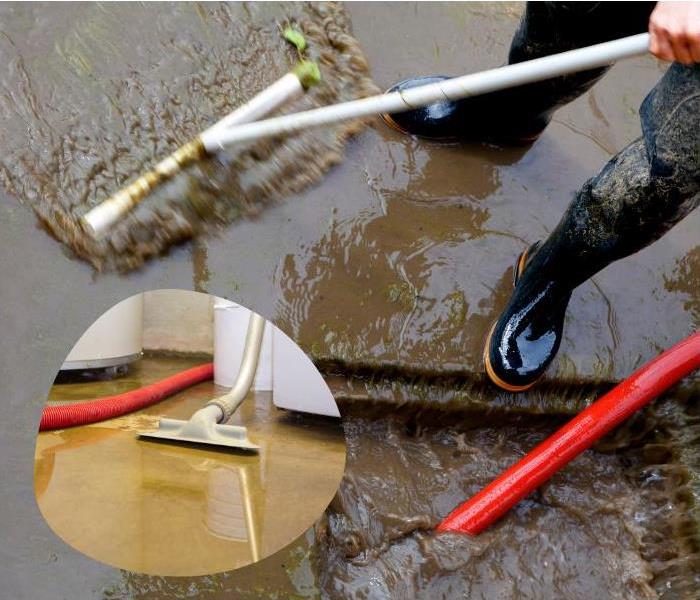 Effective Flood Cleanup in Layton, UT
Effective Flood Cleanup in Layton, UT
Flooding can be a devastating event for homeowners, causing significant damage to property and belongings. In Layton, UT, where weather conditions can occasionally lead to flooding, it's crucial to understand the steps involved in flood cleanup to ensure a swift and effective recovery. Here are five essential steps for flood cleanup that can help restore your home and safeguard your health and safety.
1. Ensure Safety First
Before beginning any flood cleanup efforts, safety should be your top priority. Floodwaters can be hazardous, containing contaminants and posing electrical risks. Follow these safety tips:
Wait for Clearance: Do not enter your home until local authorities have confirmed that it is safe to do so. Floodwaters may contain sewage, chemicals, or other harmful substances.
Turn Off Power: If it is safe to do so, turn off electricity at the main breaker to avoid electrical shock. Avoid touching electrical equipment while standing in water.
Wear Protective Gear: Equip yourself with waterproof boots, gloves, and masks to protect against contaminants and debris.
2. Document the Damage
Once it's safe to enter your home, document the damage thoroughly. This step is crucial for insurance claims and understanding the extent of the cleanup required.
Take Photos and Videos: Capture detailed images and videos of all affected areas and items. This documentation will be essential for your insurance claim and for assessing the damage.
Make a List: Create a comprehensive list of damaged items and areas. Note any structural damage, such as compromised walls, ceilings, or floors.
3. Begin the Water Removal Process
Removing standing water quickly is critical to prevent further damage and mold growth. Here’s how to approach this step:
Use a Pump: If there is significant standing water, use a submersible pump to remove it. Make sure the pump is suitable for the type of water you’re dealing with, whether it's clean or contaminated.
Wet/Dry Vacuum: For smaller amounts of water, a wet/dry vacuum can be effective. Ensure the vacuum is rated for water use and follow the manufacturer’s instructions.
Remove Wet Materials: Take out any wet materials, such as carpets, rugs, and furniture, that cannot be salvaged. Place them outside in a dry area for disposal or cleaning.
4. Clean and Dry Affected Areas
Proper cleaning and drying are essential to prevent mold growth and further damage. Follow these guidelines:
Clean Surfaces: Scrub affected surfaces with a mixture of water and detergent. Use a disinfectant to kill bacteria and prevent mold. Be sure to clean walls, floors, and any other surfaces that came into contact with floodwater.
Dry Out the Area: Use fans, dehumidifiers, and open windows to promote air circulation and speed up the drying process. Aim to remove moisture within 24-48 hours to prevent mold growth.
Inspect for Mold: After drying, inspect the area for signs of mold growth. Mold can begin to grow within 24-48 hours of exposure to moisture, so prompt action is crucial.
5. Assess and Repair Damage
Once the area is clean and dry, assess the damage and begin repairs. Address any structural or cosmetic damage to restore your home.
Inspect for Structural Damage: Check for any structural issues, such as weakened walls, floors, or ceilings. If you find significant damage, consult a professional contractor for repairs.
Replace Damaged Materials: Replace any damaged building materials, such as drywall, insulation, and flooring. Use water-resistant materials where possible to reduce the risk of future issues.
Seek Professional Help: For extensive damage, or if you’re unsure about the repair process, consider hiring a professional restoration service. SERVPRO ® of Layton offers expertise in flood cleanup and can help you navigate the complexities of restoring your home.
Flood cleanup is a critical process that requires careful attention to detail and a commitment to safety. By following these five essential steps—ensuring safety, documenting damage, removing water, cleaning and drying, and assessing and repairing—you can effectively manage the aftermath of a flood and restore your home to its pre-flood condition. In Layton, UT, where flood events can occur, being prepared and knowing the steps to take can make all the difference in a successful recovery.
For professional assistance with flood cleanup and restoration, SERVPRO ® of Layton is here to help. Our team of experts is equipped with the knowledge and tools to handle any flood damage, ensuring a swift and thorough restoration process. Contact us today to learn more about our services and how we can assist you in getting your home back to normal.
Rebounding After the Storm: How SERVPRO ® Can Help with Storm Damage Remediation and Cleanup in Layton, UT
7/3/2024 (Permalink)
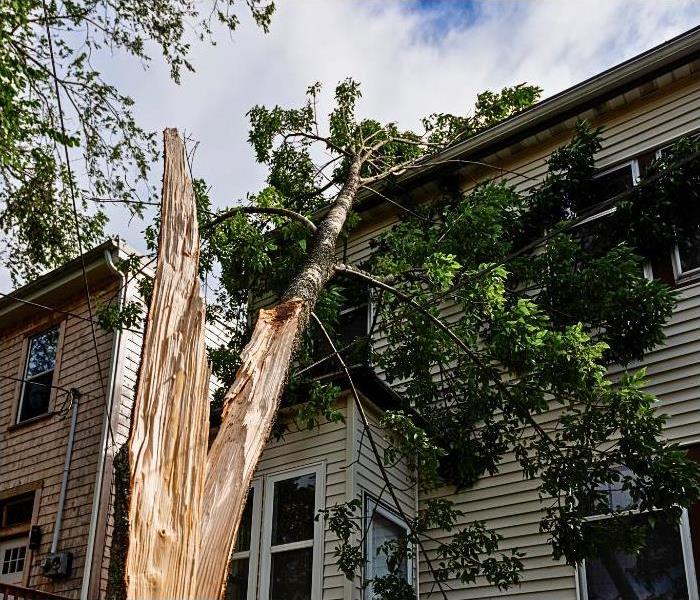 Storm Damage Remediation and Cleanup in Layton, UT
Storm Damage Remediation and Cleanup in Layton, UT
When a severe storm hits, the aftermath can be overwhelming. The strong winds, heavy rains, and lightning strikes typical of Utah’s storm season can leave your home or business in disarray. Storm damage isn't just an inconvenience; it poses significant risks to your property and health. In Layton, UT, SERVPRO® stands out as a trusted partner in storm damage remediation and cleanup. With their expertise, advanced technology, and compassionate approach, SERVPRO ® ensures that you can bounce back from any storm-related disaster swiftly and efficiently.
The Impact of Storm Damage
Storms can cause a range of damage, from minor leaks to major structural problems. Common issues include:
Water Damage: Heavy rains can lead to flooding, which can seep into basements, walls, and floors. This water can cause immediate damage and long-term issues like mold growth.
Wind Damage: Strong winds can tear off roofs, break windows, and uproot trees, causing extensive damage to the exterior and interior of buildings.
Structural Damage: Lightning strikes or fallen trees can cause severe structural damage, making homes and businesses unsafe.
Mold Growth: Water intrusion creates the perfect environment for mold to thrive, posing health risks and further damaging your property.
SERVPRO ®’s Comprehensive Approach to Storm Damage
SERVPRO ® of Layton, UT, provides a comprehensive suite of services designed to address every aspect of storm damage. Their team of professionals is equipped to handle the complexities of storm damage remediation with a structured and thorough approach.
1. Emergency Response
In the wake of a storm, time is of the essence. SERVPRO ® offers 24/7 emergency response services to address the immediate needs of storm damage. Their rapid response team arrives quickly to assess the situation and begin the remediation process, minimizing further damage.
2. Assessment and Inspection
Upon arrival, SERVPRO ® conducts a detailed inspection of the property to understand the extent of the damage. This involves identifying water damage, structural issues, and potential mold growth. This comprehensive assessment is crucial in developing an effective remediation plan.
3. Water Extraction and Drying
One of the most critical steps in storm damage remediation is removing water from the property. SERVPRO ® uses state-of-the-art water extraction equipment to remove standing water. Following extraction, industrial-grade dehumidifiers and air movers are deployed to dry out the affected areas, preventing mold growth and further water damage.
4. Mold Mitigation
If water damage has led to mold growth, SERVPRO ®’s experts are equipped to handle it. They use advanced mold remediation techniques to identify and eliminate mold, ensuring that it doesn’t spread to other areas of the property. This process includes air filtration to remove mold spores from the air and thorough cleaning of affected surfaces.
5. Structural Repairs and Reconstruction
Storms can cause significant structural damage, from damaged roofs to broken windows. SERVPRO ® provides a full range of construction services to repair and rebuild your property. Their team can handle everything from minor repairs to major reconstruction projects, ensuring your property is restored to its pre-storm condition.
6. Cleaning and Sanitizing
SERVPRO ® ensures that your home or business is thoroughly cleaned and sanitized. They use specialized cleaning techniques and products to remove dirt, debris, and contaminants brought in by the storm. This includes cleaning carpets, upholstery, and other surfaces to restore them to their original condition.
7. Insurance Claim Assistance
Navigating insurance claims after a storm can be daunting. SERVPRO ® works closely with insurance companies to simplify the claims process for their clients. They provide detailed documentation of the damage and the remediation work done, helping you get the compensation you need for repairs.
Why Choose SERVPRO ® of Layton, UT?
Choosing SERVPRO ® for storm damage remediation comes with several advantages:
Experience and Expertise: With years of experience in the industry, SERVPRO ® has honed its skills in handling storm damage of all kinds. Their team is highly trained and certified in disaster recovery and restoration.
Advanced Technology: SERVPRO ® utilizes the latest technology and equipment in the remediation and cleanup process. This ensures that the job is done efficiently and effectively, reducing the risk of further damage.
Comprehensive Services: From emergency response to reconstruction, SERVPRO ® offers a full range of services under one roof. This means you don’t have to coordinate with multiple contractors, simplifying the recovery process.
Customer-Centric Approach: SERVPRO ® understands the emotional toll that storm damage can take. They approach each project with compassion and professionalism, keeping clients informed and involved throughout the process.
Local Presence: As a locally owned and operated franchise, SERVPRO® of Layton, UT, has a deep understanding of the specific challenges faced by the community. They are committed to helping their neighbors recover and rebuild.
Steps to Take After a Storm
While SERVPRO ® provides professional remediation and cleanup services, there are steps you can take immediately after a storm to ensure your safety and start the recovery process:
Ensure Safety: Before anything else, make sure that you and your family are safe. Avoid entering severely damaged buildings and be cautious of potential hazards like downed power lines.
Document Damage: Take photos and videos of the damage to your property. This documentation will be helpful when filing insurance claims.
Contact SERVPRO ®: Reach out to SERVPRO ® of Layton, UT, as soon as possible. Their emergency response team will quickly mobilize to start the remediation process.
Notify Insurance: Inform your insurance company about the damage and begin the claims process. SERVPRO ® can assist you with the necessary documentation and communication with your insurer.
Storms are a powerful force of nature, but with the right support, you can recover and rebuild. SERVPRO ® of Layton, UT, is dedicated to helping the community restore their homes and businesses after a storm. Their comprehensive, compassionate, and expert approach ensures that storm damage is addressed promptly and effectively, allowing you to regain peace of mind and return to normalcy. Whether you're facing minor water damage or significant structural repairs, SERVPRO ® is the partner you can trust to navigate the storm’s aftermath.
Mastering the Cold: Dealing with Frozen Pipes
12/28/2023 (Permalink)
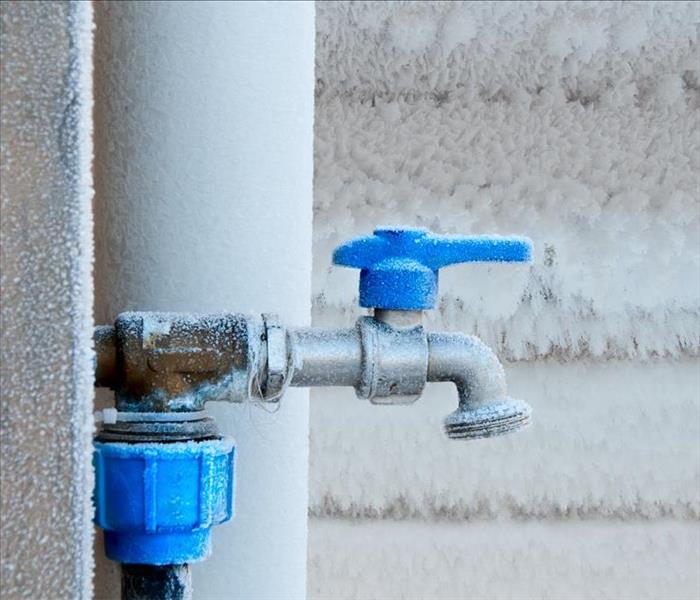 A frozen faucet in Layton, UT.
A frozen faucet in Layton, UT.
Winter in Layton, UT, paints a picturesque scene with snow-covered landscapes and crisp, chilly air. However, alongside the beauty of the season comes the risk of frozen pipes, a common woe for homeowners in colder climates. As temperatures plummet, pipes can freeze, leading to potential water damage and plumbing headaches. In this comprehensive guide, we'll explore the causes of frozen pipes, preventive measures, and effective solutions to ensure your home stays warm and watertight throughout the winter.
Understanding the Problem:
Before diving into solutions, it's crucial to understand the science behind frozen pipes. Layton, like many areas in Utah, experiences freezing temperatures during winter. When water in pipes reaches the freezing point, it expands, creating pressure within the pipes. This pressure can lead to cracks or even burst pipes, resulting in water damage to your home.
Common Causes of Frozen Pipes:
Insufficient Insulation:
Exposed pipes in unheated areas, such as basements, attics, or crawl spaces, are vulnerable to freezing.
Lack of insulation or inadequate insulation allows the cold to penetrate the pipes, putting them at risk.
Sudden Drops in Temperature:
Drastic temperature fluctuations, especially when temperatures plummet overnight, can catch pipes off guard, leading to freezing.
Neglecting Outdoor Plumbing:
Outdoor faucets and hose bibs are susceptible to freezing if not properly insulated or shut off before winter.
Preventive Measures:
- Insulate Pipes:
Identify and insulate exposed pipes using pipe insulation or heating tape. Focus on areas prone to freezing, such as basements, attics, and crawl spaces.
- Maintain a Consistent Temperature:
Keep your home's temperature steady, even when you're away. A slight increase in the thermostat setting during extremely cold weather can make a significant difference in preventing pipe freeze.
- Seal Leaks and Cracks:
Inspect your home for drafts and seal any gaps in windows, doors, and walls. This not only helps prevent frozen pipes but also improves overall energy efficiency.
- Disconnect and Drain Outdoor Hoses:
Before the cold sets in, disconnect and drain outdoor hoses. Shut off water to outdoor faucets and install faucet covers for added protection.
Dealing with Frozen Pipes:
Despite your best efforts, frozen pipes may still occur. When faced with this challenge, follow these steps to thaw them safely:
- Identify the Frozen Section:
Determine which pipes are frozen by checking for areas with reduced or no water flow. Faucets that produce a slow trickle or no water at all may indicate a frozen pipe.
- Open Faucets:
Before attempting to thaw the pipes, open the affected faucets. This will relieve pressure and allow water to flow once the ice blockage begins to melt.
- Apply Heat: Use a gentle heat source to thaw the frozen pipes. Electric heating pads, hairdryers, or space heaters can be effective. Never use an open flame, as it poses a fire hazard.
- Work from the Faucet Outward:
Start applying heat near the faucet and work your way toward the frozen section. This helps melt the ice gradually and prevents pressure buildup.
- Inspect for Damage:
Once the pipes have thawed, check for any visible damage. Look for cracks, leaks, or signs of weakness. If you notice any issues, it's advisable to consult a professional plumber for repairs.
Dealing with frozen pipes in Layton, UT, requires a combination of preventive measures and effective thawing techniques. By taking proactive steps to safeguard your plumbing and knowing how to safely thaw frozen pipes, you can navigate the winter chill without the worry of plumbing disasters. Remember, a little preparation goes a long way in ensuring a warm and water-filled home during the coldest months of the year. Stay warm, stay informed, and enjoy a cozy winter in Layton!
Rain May Lead to Mold Growth
8/18/2023 (Permalink)
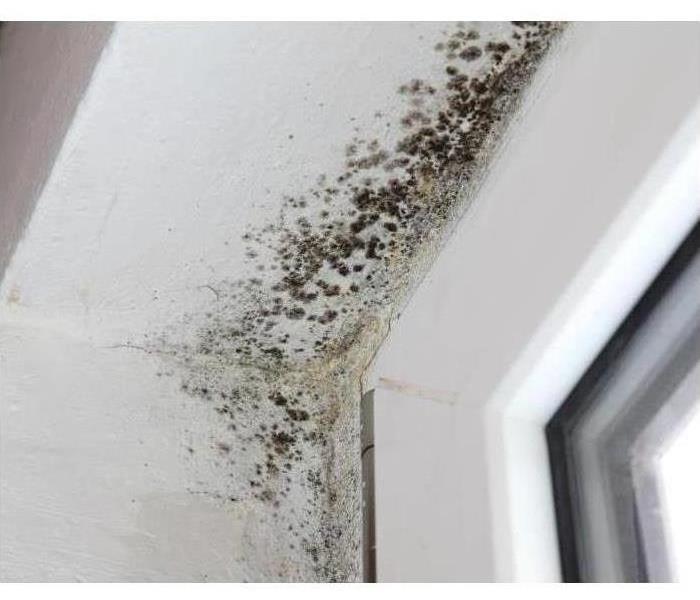 Mold growth found after a storm in Layton, UT.
Mold growth found after a storm in Layton, UT.
Black mold can show up in your Layton, Utah, house seemingly overnight. Have you noticed a connection between rainy days and mold growth? There are a few instances when rain can lead to mold popping up in your home.
5 Reasons Rain May Lead to Mold Growth
- Faulty Roof: If your roof is missing shingles, it may not be able to keep water out of your home like it should. This can lead to water buildup in your attic or drips down your walls, which invites mold spores to make a home.
- Bad Foundation: Cracks in your foundation could be another way excess moisture makes it into your home. During the rain, the falling water goes into the ground and starts to travel. If your foundation isn't properly sealed, the water can find its way into your home.
- Poor Attic Ventilation: When the attic does not have proper ventilation, condensation can start to build up in the space. Even condensation is enough of a moisture problem to allow black mold to make a home.
- Worn-Out Weather Strips: Weather stripping around windows and doors can become cracked and faded over time. When it rains, the water may seep its way into these crevices. Mold may start to build up around your windows and doors because of the trapped moisture.
- Too Much Water: Heavy rains can lead to too much water for an environment. When this happens, floods can fill your basement or garage. Flooding is a common cause of mold growth.
No matter what issue has caused your moisture problem, you need to get to the heart of the issue. Wiping away the surface mold won't help you rid your home of the fungus. Instead, you need to call in a professional mold cleanup crew.
Rain sometimes exacerbates issues with your home. If you notice black mold pop up after every downpour, it could be tied to a bigger issue with your house.
5 Steps for Flood Cleanup
8/4/2023 (Permalink)
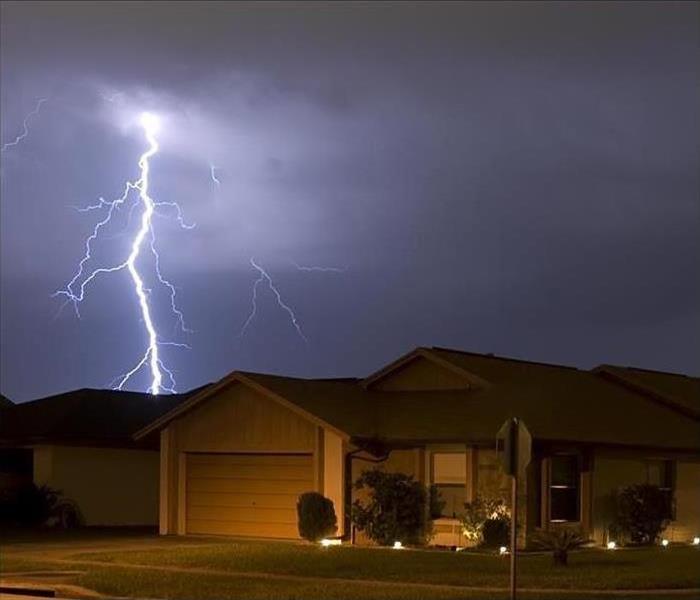 Thurnderstorm in Layton, UT.
Thurnderstorm in Layton, UT.
Floods come in all shapes and sizes, from minor plumbing leaks to major storm surges. It is often difficult to see a level of your home underwater, and it can leave you wondering about specific cleaning requirements. Most water damage specialists in Layton, UT, suggest a five-step process for flood recovery.
5 Step Process for Flood Cleanup
- Remove Water From Interior
The primary objective after a storm surge is to remove the water, not to perform flood clean up. Most professionals will use a combination of shop vacs, portable pumps, and pumping trucks, depending on the depth of the flood.
- Dry the Interior
Thoroughly drying the space is among the most important cleaning requirements. Mold can begin growing within 24 to 48 hours after water damage. The quicker you can dry the space, the less chance for other problems to arise. Restoration companies often use air movers, dehumidifiers, and fans to help move the drying process along.
- Mitigate Further Loss
A significant concern for many homeowners is mitigating further loss. Most insurers require homeowners to protect the property from greater harm or risk their claim. Disaster response teams might suggest using plywood to cover vertical damage, like broken windows, and tarps for horizontal damage, like wind-torn roofs.
- Clean and Disinfect
Before you know it, the disaster response crew will explain how to flood disinfectant and clean your space. The team you hire will remove all debris, and use commercial products to eliminate any harmful bacteria.
- Restore the Space
With the space clean and dry, the team can begin focusing on any structural repairs. The restoration phase is about removing any sign of storm damage and making your house look like never even happened.
The cleaning requirements after a flood or storm surge are simple: remove water, dry the space, protect, clean, and repair. However, depending on the damage, a homeowner might want to consider calling a professional for help.
What You Need To Know About Flooding, Flood Insurance, and FEMA
7/19/2022 (Permalink)
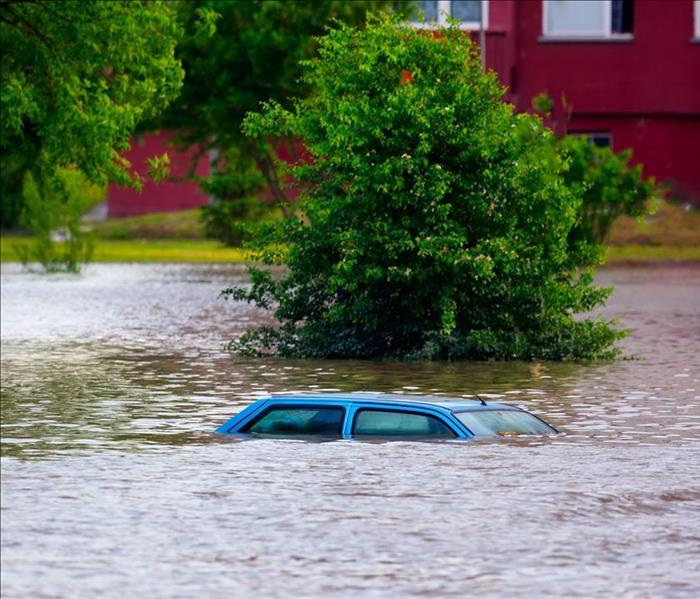 Flooding can cause severe damage.
Flooding can cause severe damage.
Floods are some of the most common types of natural disasters throughout the United States, and there are several sources of natural flooding:
- Prolonged rainfall
- Heavy snowmelt
- Powerful storms
- Broken dams
- Lack of drainage
Unfortunately, even homes that aren’t situated on a flood plane can be vulnerable to these disasters.
What Is the Importance of Flood Insurance?
Whether the risk to your home in Layton, UT, is obvious or not, it’s important to add flood insurance to your policy. This additional coverage is the best way to protect your home and family from significant loss.
What You Need To Know About Urban Flooding
Urban flooding happens when a community’s infrastructure isn’t prepared to handle heavy rainfall. In this case, water flows from roads, sidewalks, parking lots, and other surfaces into storm drains, ultimately overflowing into yards or up through residential sewer systems. Communities that aren’t located in flood zones are experiencing more risk of street flooding, overwhelmed sewer systems, and flooded neighborhoods because of heavy or prolonged rainstorms. This means that even if you haven’t had a problem with rainfall flooding in the past, you could be caught in a disaster situation in the future.
What To Do if You Don’t Have the Right Insurance
What if you don’t have coverage for flooding? You may still have some recourse through the federal government. The Small Business Administration offers loans, and the Federal Emergency Management Agency offers grants to cover some related expenses.
Loans for home repairs through the SBA are classified as disaster loans. You will have to pay back the money you receive, but you can count on low-interest rates with extended repayment periods, often up to 30 years. The specific repayment terms for your loan are determined by your specific circumstances. An SBA disaster loan can be used to repair and replace your home and your personal property, including cars. You won’t be allowed to use the funds for additions or upgrades to your home, but they may cover any work done by water damage cleanup and repair professionals. Even if you don’t think you’ll use the loan, it’s a good idea to apply because this could also help you qualify for other funds.
FEMA provides grants for families located in federally recognized disaster areas. These grants are available through the Individuals and Households Program and are generally meant to cover expenses that aren’t covered by your existing insurance policy. Unlike the broad coverage allowed by the SBA loan, the funds you receive through this grant are strictly controlled. For example, you can only use these funds to return your home to a habitable state, not to return it to its original condition.
What You Can Do Now
If you live in a flood zone, you should immediately contact your insurance provider and add flood insurance to your existing coverage. If you don’t live in a flood zone, it’s still worth discussing the risk with your insurance provider. Insurance companies are often an excellent resource for ideas about floodproofing your home and landscape. The steps you take now are much easier than the work required to recover from flooding.
Hail Damage
7/12/2022 (Permalink)
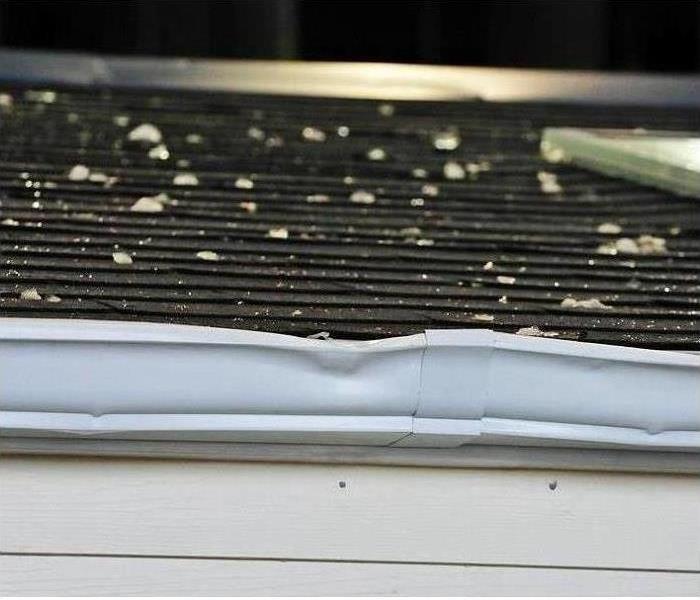 Hail can leave a lot of damage that we need to look for to avoid further loss in the future.
Hail can leave a lot of damage that we need to look for to avoid further loss in the future.
The dreaded sound of ice pellets hitting your office window tells you that the storm has become more than just wind and water. When you experience a hailstorm in Kaysville, Utah, it can cause extensive storm damage to your commercial property. You can hire professionals to take care of roof damage so that you avoid bigger problems in the future. Here are some other problems to check for after hail.
2 Problems to Check for After Hail
- Cracked or Missing Shingles. Hail damage to the roof can break your shingles.
Some shingles may even come loose or detach completely. A roofing company is generally required to fix the roof, but luckily most building insurance packages have provisions to cover at least part of the cost.
- Leaks. Roof damage can lead to leaks, which in turn can lead to a whole slew of other problems.
A wet attic that goes unnoticed can foster mold growth, turning a water problem into a mold remediation problem. It can also cause insulation to get wet, which renders it ineffective. If that happens, it needs to be replaced. Flood mitigation specialists can test areas with water damage to make sure they are remediated properly.
3 Tips for Protecting Your Business from Storm Winds
6/7/2022 (Permalink)
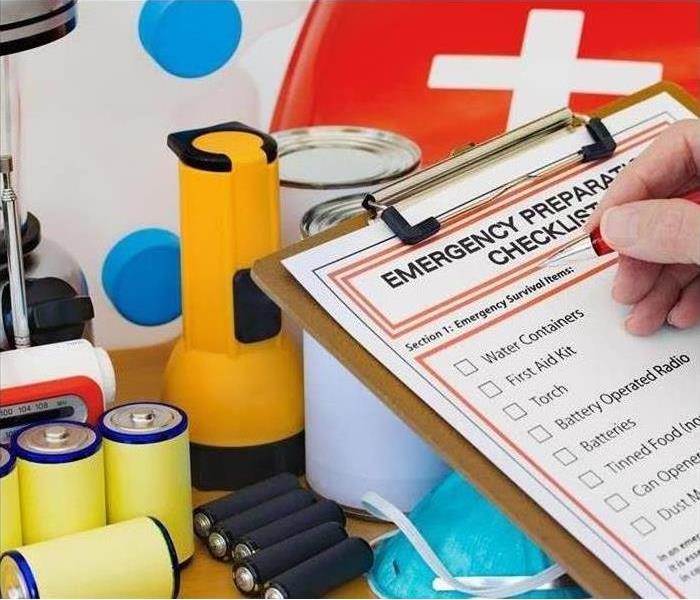 Create an emergency preparedness checklist for your Business.
Create an emergency preparedness checklist for your Business.
For a business in Layton, UT, being prepared for hurricane damage can help save you valuable time and money. In many cases storm damage can obstruct the normal business flow, meaning that the better prepared you are beforehand, the quicker you can get back up and running. Here's some tips many storm damage restoration professionals recommend for protecting your company.
Tips recommended by Specialists- Create a Storm Task List
One thing you can do to help prepare your company for a storm is to create a task list ahead of time of things you may require. This list may include gathering storm supplies such as blankets, extra food, batteries, radios, flashlights, and other gear, as well as tasks to help prepare your company buildings against inclement weather.
- Storm Prep Any Company Property
You may also want to prepare your property against hurricane damage ahead of time by investing in shutters, storm windows and doors, or a backup server for any electronic files. It's also recommended to have your roof inspected on a regular basis if you're located in an area with heavy weather. When you know a storm is coming you may want to sandbag areas prone to flooding, turn off electricity, and secure any exterior items against the weather.
- Keep Your Documentation Safe
During a storm high winds may occur that can cause debris to be thrown into your company property. This can cause damage both to the exterior and interior of your building. Such damage could lead to the loss of any files or documentation you may have. One prevention measure against this is to secure your files away from areas that are more prone to damage. You may choose to backup any electronic files onto our server as well.
If you're concerned about hurricane damage occurring to your business, then following these preparedness tips may help. Create a list of everything you'll need to do in the event of the storm, and be ready to storm prep any company property. You may also want to ensure that all your documentation is secured. If you have any questions or professional might be able to help.
Common Damage Caused by Winter Storms
5/24/2022 (Permalink)
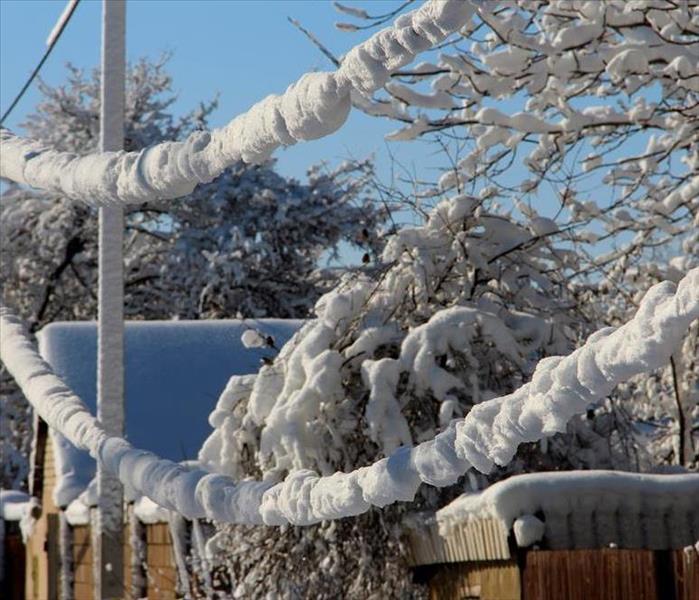 Be ready for Winter Storms by Following These Tips.
Be ready for Winter Storms by Following These Tips.
For homeowners in Kaysville, UT, a severe winter storm is to be expected. What homeowners may not expect is extensive damage from the storm that requires a storm and water damage restoration company to repair.
The Effects of a Blizzard
When dealing with ice, snow and sleet, your home may not be ready to handle what they may bring. Instead of hoping for the best, homeowners should have a good understanding of the common causes of water and roof damage during cold weather. These include:
Wet Snow:
Extra-heavy, moisture-filled snow early in the winter easily accumulates. As it does so, this extra weight puts stress on power lines, roofs, trees and other structures. Over time, only a few feet of snow may be enough to cause damage.
Ice:
Similar to wet snow, the weight of ice is too much for some structures. As the rain turns to ice, it can create layers of ice that can be detrimental to your home and the power grid. If ice dams form on the roof, it means that moisture is being pushed under the protective roof layers and may lead to extensive damage.
High Winds:
No matter the season, strong winds often accompany moisture. That often leads to missing shingles, falling branches and siding going missing. Combined with frigid temperatures, it may leave your roof and structural components of the home exposed to moisture.
Flooding:
Along with potential flooding after the snow melts, freezing temperatures during a winter storm also lead to frozen pipes. If ice has built up, it may be blocking the melting snow from properly draining. If that happens, you may easily find unwanted water in your home.
Prevention Tips
While you may not be able to prevent the storm from brewing, there are ways to minimize its impact on your home. A key to ensuring your home is ready for any storm is staying on top of maintenance throughout the year. Key ways to minimize the effects of ice and snow include:
- Get the roof inspected annually to ensure it is in good shape and up to code.
- Regularly check the foundation for any cracks, leaks or missing seals prior to the storm.
- Prior to winter setting in, disconnect any outdoor hoses and insulate faucets.
- Check doors and windows for any gaps and install weather stripping to help keep the cold out.
- Clean the gutters to reduce the chances of ice dams forming.
- Keep tree branches trimmed and away from the home.
Along with trying to prevent damage to your home, winter weather also requires thinking about safety. Before the cold season starts, it’s a good idea to have your heating system checked to ensure it is running properly. That is also a good time to stock up on salt to keep driveways and walkways less slippery.
Any winter storm has the potential to wreak havoc. While the winter wonderland may look pretty, ice and snow can cause different types of damage to the home. Staying on top of maintenance and being prepared are key ways to minimize the damage.
Mold Concerns After a Residential Flood
2/22/2022 (Permalink)
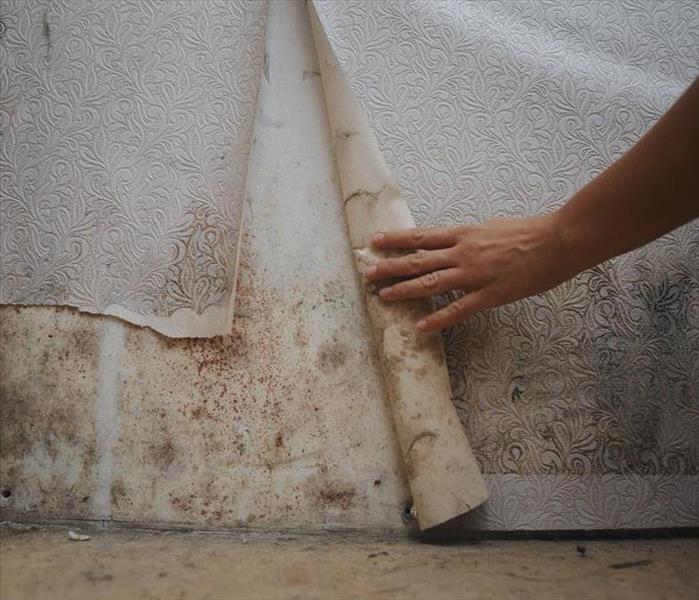 Bear in mind these Important Tips if you experience Mold Growth after a Residential Flood in your Kaysville, UT property.
Bear in mind these Important Tips if you experience Mold Growth after a Residential Flood in your Kaysville, UT property.
On the weather radar, when you see heavy rains approaching Kaysville, UT, you know your home could be susceptible to flooding. Several variables can cause home water intrusions, such as inadequate landscaping, a leaky roof, faulty plumbing, or foundation cracks. Water left to sit stagnant in your home can soon lead to more than simply loss from the water itself.
Secondary damage, such as mold growth, is also a significant concern. Fortunately, if you take care of the moisture problem quickly enough, you can usually avoid a mold problem.
You Can Prevent Mold Growth After a Water Intrusion
Mold can begin growing 24 to 48 hours after the spores contact moisture. Therefore, you must clean the affected area as soon as possible. Here are several steps to ensuring your house is safe from this tiny invader following a flooded floor.
1. Extract the Standing Water From the Floor
First, removing the standing water is critical to preventing mold. Typically, the simplest and quickest way of doing this is using a wet/dry vacuum. They can be rented from hardware and home improvement stores, but keeping one on hand at your home can be a great help.
2. Determine Which Contents Are Salvageable
Mold is a tiny but hardy little lifeform; it can grow on virtually any surface. Therefore, you should remove as many water-soaked materials as possible from the area. This can include flooring, drywall and wood and upholstered furniture. Many of these items will not be salvageable and should be thrown away. Whatever you are keeping must be thoroughly dried before returning to the area. If the humidity of the outdoors is lower than that of the affected area, you can allow the contents to dry in the fresh air.
3. Clean the Affected Area and Salvageable Contents
You must clean everything that comes into contact with the water thoroughly. A flood can bring in debris, bacteria and hazardous chemicals. This will also remove most of the mold spores that are there. Ideally, you can hire water damage restoration experts to bring their expertise and industrial equipment.
4. Sanitize the Affected Area and Salvageable Contents
Next, you must sanitize everything to kill the remaining harmful germs and mold spores. Sanitizing will go one step further in ensuring you avoid mold development.
5. Dry Everything Completely
Finally, the most crucial step is to ensure you dry the area thoroughly as quickly as possible. There are several approaches you can take to dry a room. You can open windows and doors to let the fresh air in. You can also run fans, heaters and dehumidifiers. If you use a dehumidifier, it's critical to remember to empty the water receptacle before it gets full, so it can continue trapping the excess moisture from the air.
Mold growth can be one of the most extreme secondary hazards that a home flood commonly produce. It can develop quickly and spread furiously throughout unaffected areas of a structure. If you discover standing water in your residence, following these five steps can help ensure that you will mitigate the loss. These steps will allow you to confidently restore your home to its pre-flood condition.
How Can I Stay Safe in Floodwaters as a First Responder?
1/24/2022 (Permalink)
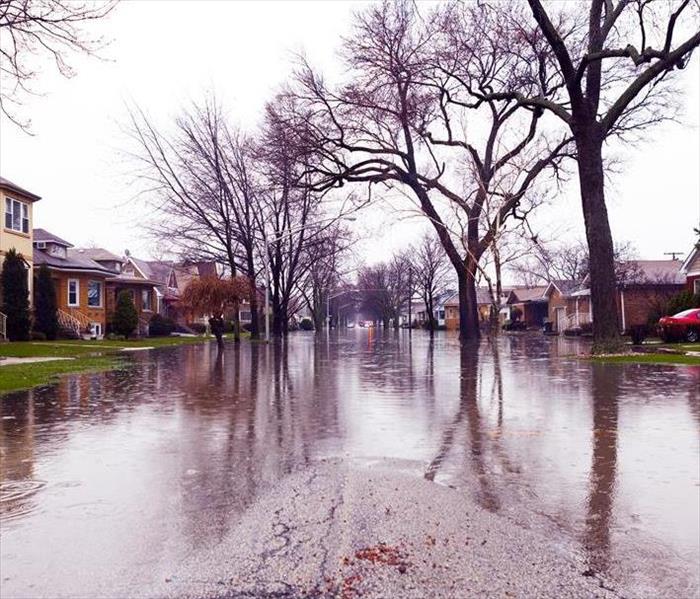 Consider this Important information if you are a First Responder in Layton, UT. If any doubt arises, please contact us.
Consider this Important information if you are a First Responder in Layton, UT. If any doubt arises, please contact us.
As a first responder in Layton, UT, you are responsible for going into situations that most people try to avoid or escape. You are even saving lives at times. You may be more concerned about rendering help to the victims than considering your own safety. However, it's vital to know all of the daily risks of your job. You must understand all of the hazards each disaster situation can present and always be aware of the necessary precautions. Working in the emergency services field can be extremely rewarding. Keep in mind, though, that if you aren't healthy, you can't be at your best while trying to help others. Working a flood response can be one of the most precarious conditions in which to work.
Important information to consider if you are a First Responder
The Dangers of Floodwaters
Navigating deep waters after a major storm often presents multiple risks. There are three classes of water; each type poses progressively increased contamination levels. Black water is the most dangerous, as it is full of pollutants. The water alone sometimes isn't even the most significant threat. Always be aware of the following hazards:
1. The Various Contaminants in the Water
A flood from heavy rains can contain various types of bacteria, potentially harmful chemicals, and other contaminants that can make you sick if you contact them without the proper protection. Even if the water looks relatively clean, it can be incredibly hazardous. Therefore, it's vital to protect yourself by wearing personal protective equipment, such as that worn by storm damage restoration professionals, the entire time you're in contact with the water or anything that has touched the water. This PPE will typically include safety glasses and a respirator, along with waterproof gloves, coveralls and rubber boots. Avoid touching your face until you sanitize your hands. Also, avoid allowing open wounds to come into contact with the water.
2. The Risk of Contracting Diseases
Even if your job as a first responder doesn't require you to have certain immunizations, it's essential to keep up with vaccines. Hepatitis B and tetanus are real threats for anyone making contact with contaminated water. Ensuring that you're fully vaccinated can give you peace of mind knowing you have an added layer of protection in a hazardous environment.
3. The Strength of Floodwaters
Many people don't realize the strength of floodwaters until it's too late to avoid them. Even mere inches of water can carry away a car, so it doesn't take much to knock you off your feet. Even waters that appear to be still can have an undertow that can sweep you away. Always be extremely cautious before you approach standing water, whether on foot or in a vehicle.
You have an incredible amount of responsibility and stress when working as a first responder. It's easy to get caught up with helping victims during emergencies such as floods. People depend on you at their most vulnerable times. Nevertheless, you must always be cautious concerning your own safety so you can continue to perform at your best. Continually stay mindful of ways to keep yourself as safe as possible while you're on the job.
Content Cleaning After Flooding: What You Need To Know
10/18/2021 (Permalink)
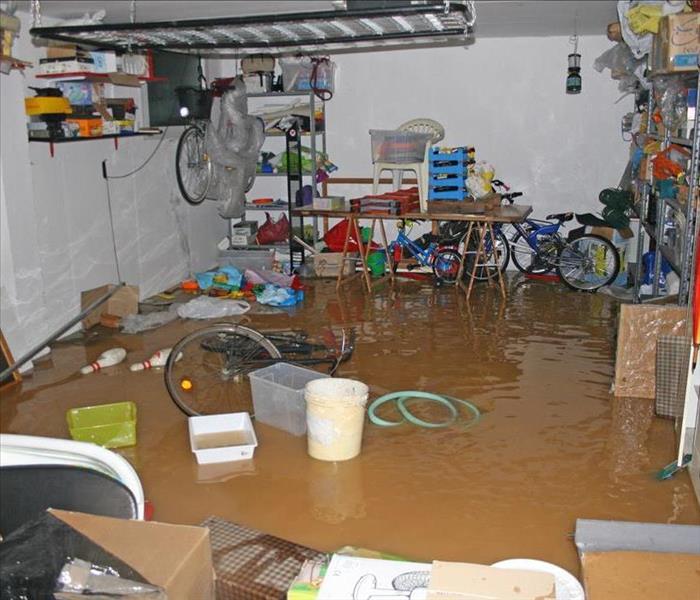 Clean up properly after a storm and flood to avoid severe damage in your Layton, UT, home.
Clean up properly after a storm and flood to avoid severe damage in your Layton, UT, home.
When your Layton, UT, home has been devastated by flooding, one of the most pressing issues you'll face is how to handle content cleaning. In those first few moments, your attention may naturally be drawn to structural damage, such as weakened flooring and soggy drywall. You may also consider the risk associated with secondary damages:
- Mold growth
- Frayed and exposed wiring
- Lingering odors
However, the longer it takes for you to think about waterlogged sofas and moist linens, the easier it will be for damage to set in and the more expensive it will be to replace those items.
Content Cleaning Steps You Should Take
One of the first things you need to do is understand the categories of contaminated water. Professional water damage cleanup technicians will assess the damage in your home and alert you to the scope of water contamination:
Category 1: Clean water comes directly from the faucet or a clean water supply line. Once water leaves the faucet or broken pipe, it is exposed to contaminants and degrade to category 2 or 3.
Category 2: Gray water carries some contamination, such as urine or detergents. When this water damage isn't addressed, the situation could deteriorate to category 3.
Category 3: Black water is contaminated with harsh chemicals, feces, heavy metals, and other pollutants. You should not come into contact with black water or any belongings exposed to it.
Unfortunately, if your flood originated from a heavy storm, overflowing river, or backed-up sewer, you're probably dealing with a category 3 situation.
Sort Belongings for Keeping, Cleaning, and Discarding
The next step is organizing the contents of your home into items that don't require cleaning, those that can be cleaned and repaired, and those that should be thrown away. Work closely with water damage cleanup and restoration professionals to understand the differences in these categories. For example, if clothing and window treatments remained dry in an unaffected part of the home, they probably don't require cleaning, disinfection, and deodorization. If those same belongings were in the same area as the flooding, they may have absorbed some of the moisture and contaminants. A good rule of thumb is that porous materials should be discarded, and non-porous items can be cleaned and saved.
Do-It-Yourself or Hire a Professional
In the aftermath of a flood, you are justifiably concerned about keeping your costs down, so when it comes to content cleaning, you may be tempted to handle a lot of it yourself. Some of the cleaning you can do, such as running uncontaminated linens through the washing machine. However, expensive window treatments, rugs, and contaminated textiles should be handled by professionals. There are several other belongings that should be treated by experts:
- Water-damaged computers, electronics, and appliances
- Important books, pictures, and paperwork
- Dry-clean only goods
- Family heirlooms and valuable belongings
Unfortunately, the DIY approach often leads to further damage and more expensive repairs. Don't put your belongings at further risk in an already stressful situation.
Water contamination is a serious risk after a home flood. Your home and family will be better off when you know how to safely handle content cleaning. Reach out to professionals when you have questions and concerns.
Tips for Protecting Your Home From Floodwater
8/18/2021 (Permalink)
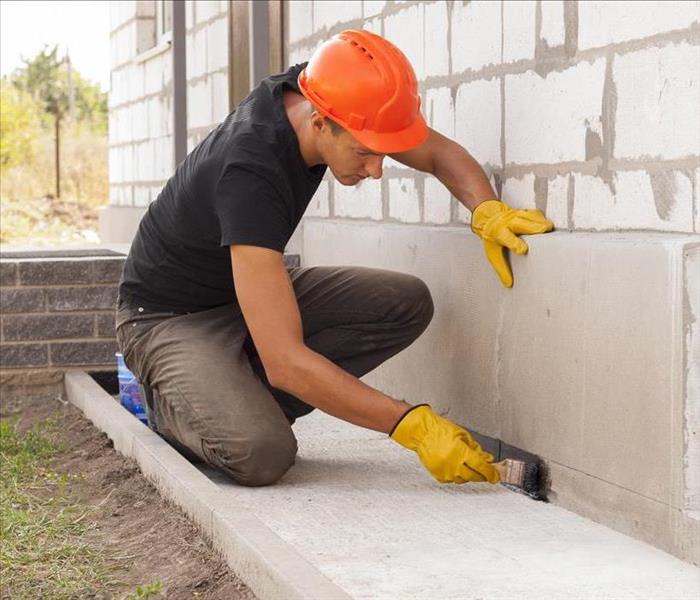 Flooded homes in Kaysville, UT, are common but exist several ways to protect your house from water damage.
Flooded homes in Kaysville, UT, are common but exist several ways to protect your house from water damage.
Flooding is a common result of extreme weather and causes some of the most common property damage reported to insurance companies. If your Kaysville, UT, home has been exposed to flooding in the past or if you're concerned about the potential for future water damage, it's important to consider flood safety and any steps you can take to keep your home and family above water.
Focus on Staying Above the Water Level
The best way to protect against water damage is to keep your home and belongings higher than the water. Although this isn't always possible, you can learn where the flood level is for your home. With this information, you can focus on the part of your home that is most likely to be damaged. This information may be available through your home insurance provider or the local building department. There are a few steps you can consider at this point:
- Install raised structures, such as concrete blocks, for air conditioning units and other outdoor equipment. Make sure these structures are anchored securely, so floodwater doesn't carry them away.
- Floodproof your home by applying protective sealants and coatings to the walls that will prevent water from seeking into the foundation.
- Add foundation vents to your home to direct water through a path that you determine. This keeps water away from the rest of your house and limits the amount of damage.
- Hire professionals to lift your home on columns or piers, so the lowest level of your home is higher than the flood level.
Direct Water Away From Your Home
Naturally, you'll want to be sure that the grade of the land slopes away from your home. The next time it rains, watch where water pools and flows and then make necessary adjustments. There are several changes you can make to your landscape to floodproof your home and property:
- Install gutters around the roof of your home and keep them clear.
- Create a splash block or drainage area under the downspout to direct water away from the foundation.
- Choose native plants that support the soil in Kaysville, UT.
- Add a drainage system, such as a rain garden, swale, rain barrels, sump pump, or French drain.
If you see a lot of standing water in the street after a rainstorm, contact your county planning department for further suggestions to increase flood safety around your home.
Install Backflow Valves
Flooded sewer systems are an unpleasant result of natural flooding. You can prevent sewage from backing up into your home by installing backflow valves on all pipes that enter your home. Make sure that these are operational with regular inspections.
Keep Yourself and Your Family Safe
When flooding does occur, your top priority should be your well-being and that of your loved ones. This means following flood safety tips, such as not driving into pools of water, staying out of floodwater, turning off the electricity to your home, and contacting water damage cleanup and repair professionals.
The best time to tackle flood safety is before the clouds come out. Review these tips and reach out to your insurance provider or local environmental professionals for more advice.
Commercial Floods: When Can Employees Go Back to Work?
7/29/2021 (Permalink)
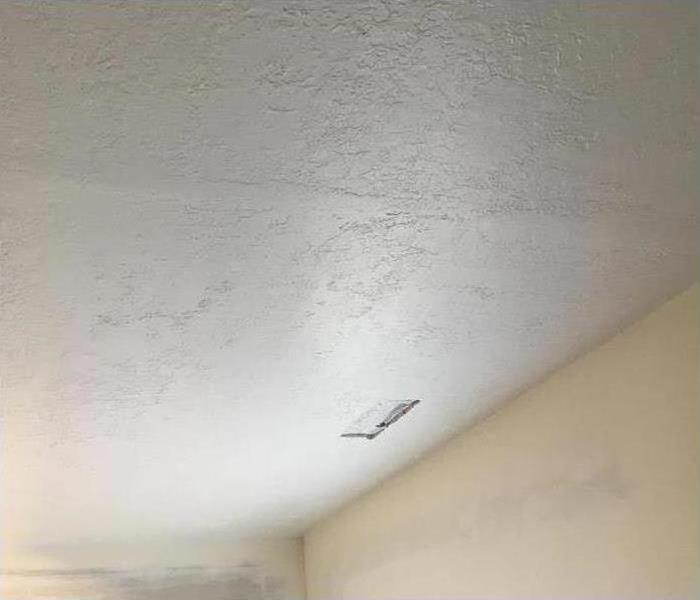 Ceiling damage after a storm in a Layton, UT home
Ceiling damage after a storm in a Layton, UT home
If you have sustained black water damage at your Layton, UT, business after a flood, you may be wondering when your employees can return to work. You will likely need to do a couple of things to return the workplace to its pre-flood condition, and the two main steps involved are demolition and disinfection, both of which can be enhanced by the use of air filtration devices.
Familiarize yourself with these different phases of restoration to understand what you need to do to restore your property. Once complete, your employees should be able to go back to work in a timely manner.
1. Demolition
Demolition involves removing water and items that have been affected by black water. It also includes disposing of property that has sustained water damage. This is an extremely important first step when trying to restore your commercial building to a state that allows your employees to enter it. An air filtration device can help speed things up by causing enhanced drying of wet areas of the structure. This is typically a good time to bring in a commercial storm damage company to help you make sure that everything is cleaned up as thoroughly as possible.
2. Disinfection
The next step in the flood cleanup process is disinfection, which helps eradicate any existing infected areas and prevents others from being contaminated in the future. Best practices include cleaning all damaged or wet areas with products approved by the EPA. An air filtration device can help during this stage by purifying the air and reducing the risk of impure particles sticking around your property.
The best defense against black water is to be prepared in advance so that you know what you can do to reduce the risk of water damage and how you can prepare the premises so your workforce can get back to being productive. In cases where you are unfortunately already facing flooding issues, the action plan above will typically be your best bet in returning your company to its normal state in the least amount of time.
Protecting the Interior of Your Home From External Flooding
7/14/2021 (Permalink)
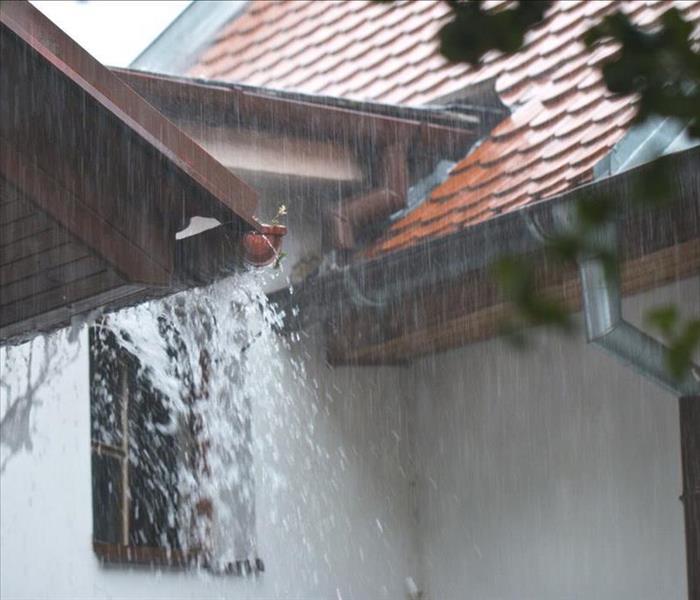 Storm damage must be repaired by a professional and certified team.
Storm damage must be repaired by a professional and certified team.
A rainstorm can lead to significant flooding around your property, especially if it is a sudden downpour. While much of the damage might occur around the home's exterior because of outside flooding, it is not uncommon for the water to find its way inside, primarily if your landscaping is not properly sloped or the foundation is not correctly or adequately sealed. If the interior of your home floods, you might need to contact a water removal service in Layton, Utah. These services specialize in several areas:
- Mitigation
- Remediation
- Restoration
However, you could avoid the expense of hiring such a service if you plan ahead. By designing your landscaping to steer water away from your foundation, you can avoid most storm-related floods.
Upgrade and Maintain Your Gutters and Downspouts
Gutters and downspouts are a primary cause of outside flooding becoming inside flooding. When gutters are clogged or downspouts inadequate, the water tends to overflow from the gutter system, draining down the side of your home. The water then collects near your foundation.
To avoid such damage, you can upgrade your gutter system, especially if it is inadequate for your property. On top of that, maintain the gutters. Clean them and the downspouts often to ensure water can flow freely.
Use Mulch in Garden Beds and Around Bushes, Shrubs, and Trees
You want to design your landscaping so that the soil and beds slope away from the foundation, allowing rain drainage to flow towards sewers or streets. Installing sloped beds will not be effective if the rain can soak into the soil too quickly. Laying mulch around plants and through garden beds can help to slow soil absorption, allowing the rainwater to drain away from the house and take its time doing so.
Avoiding outside flooding is not always possible, but using landscaping to guide water away from your home’s foundation is. Focus on installing an adequate gutter system and sloping garden beds to protect your home.
Dos and Don'ts During a Flood
5/28/2021 (Permalink)
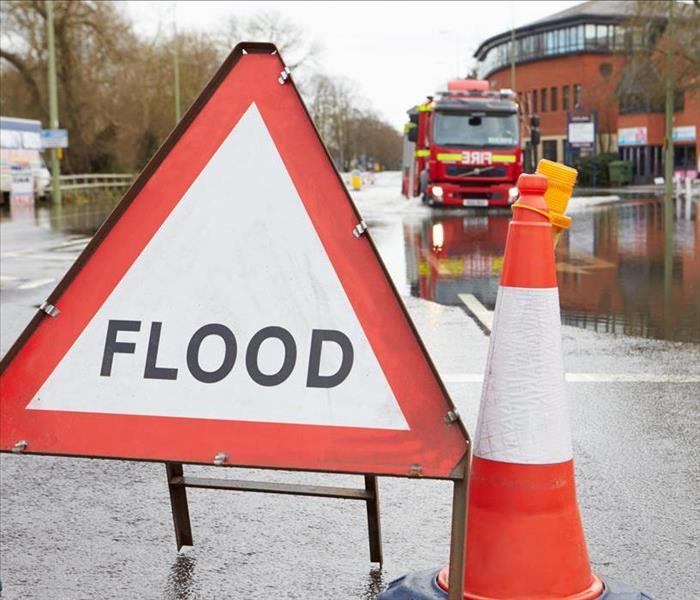 Flooding can be dangerous.
Flooding can be dangerous.
Even seemingly shallow flood water poses many hidden dangers. The more you know about those dangers before you experience a flooded home, the better you can avoid those dangers and resulting water damage.
What To Do And Not Do During a Flood
What You Should Do After a Flood
As flood water begins to recede, you may feel anxious to begin your cleaning and repair efforts. Before you wade into the murky water, however, focus on some safety steps:
- Tune a battery-powered radio to a Layton, UT, news channel for updates from utility companies and other local officials.
Turn off electricity, water, and gas throughout your home. This is especially important if you plan to evacuate.
- Open the doors and windows to allow ventilation.
- If it is safe to be in your home, move electronics, belongings, and valuables from wet areas of the home and into dry rooms.
- Take pictures of the damage for your insurance company.
- Contact water damage cleanup and restoration professionals to assess the property damage and provide an estimate for their work.
What You Should Not Do After a Flood
In addition to the steps you should take, there are several things you should not do. Avoiding flood-related dangers can keep your family safer and could prevent further damage:
- Stay out of the water. This includes on the roads and sidewalks around your home. It also means staying out of water inside your home. The water may contain harmful chemicals and biohazards. It is also difficult to tell how strong the current is, even in shallow water.
- Don't touch the water in your home. In addition to carrying contaminants, the water in your home could also be carrying an electrical charge.
- Don't ignore the warnings and directions provided by emergency responders. When you disobey those professionals, you put your own safety and the safety of others at risk. You also make the jobs of firefighters, police officers, first responders, and other officials much harder.
Stay Calm and Informed
Flood water can cause a lot of damage, but your calm, informed response can help you avoid extra problems. Your knowledge of what to do and not to do may keep you, your family, and your home safe.
3 Ways To Use Your Landscaping To Protect Your Home From Storm Damage
1/26/2021 (Permalink)
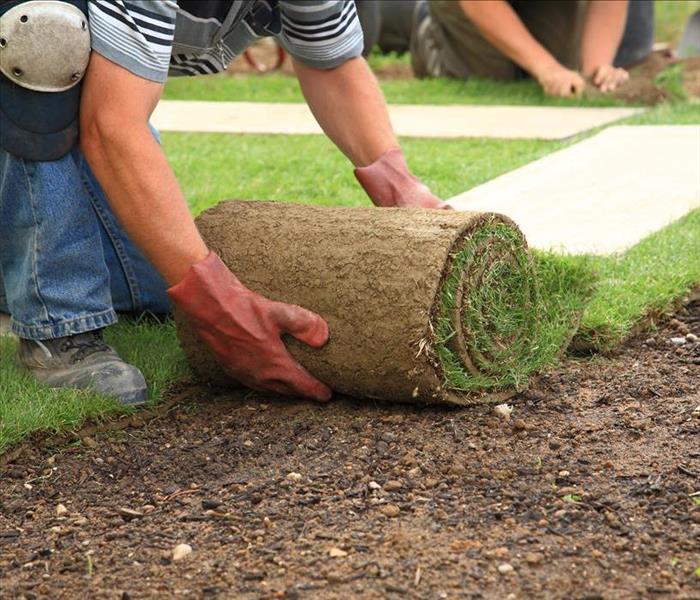 Use your landscaping to protect your home from storm damage.
Use your landscaping to protect your home from storm damage.
It isn't possible to completely protect your home from outside flooding and other storm damage. However, there are steps you can take to reduce the chance of your home suffering severe damage. These are three ways you can use your landscaping to protect your home from storm damage.
3 Ways to Protect Your Home Using Landscaping
1. Plant Trees With Deep Roots
Trees that are shallowly rooted in ground that has become saturated during a rain storm may fall over in high winds. To avoid this issue, choose trees that have deep root systems and plant them in soil that drains well. Consider the mature height of the tree and avoid planting it where it could fall on your house or power lines.
2. Install a French Drain System
One of the best ways to prevent damage from outside flooding is to divert water away from your home's foundation. Begin your French drain installation by digging a trench and lining it with landscape fabric. Add some gravel and perforated piping. The holes in the piping should face down to redirect water away from your home. Wrap the fabric and gravel around the piping and fill it with gravel, decorative rock or sod. Your trench needs to be on a slope of at least one percent for the rain drainage to be effective.
3. Create a Dry Streambed
Another way to redirect water away from your house is to create a dry streambed. When it rains, the bed provides a natural path for water to follow. The dry streambed will need to be placed on ground that slopes away from your home. If flooding does occur in your home, contact a water remediation company in Layton, UT, to dry out your property.
Outside flooding can cause severe damage to your home. One of the best ways to avoid or reduce this damage is to find ways to use your landscaping to protect your home from storm damage.






 24/7 Emergency Service
24/7 Emergency Service
















